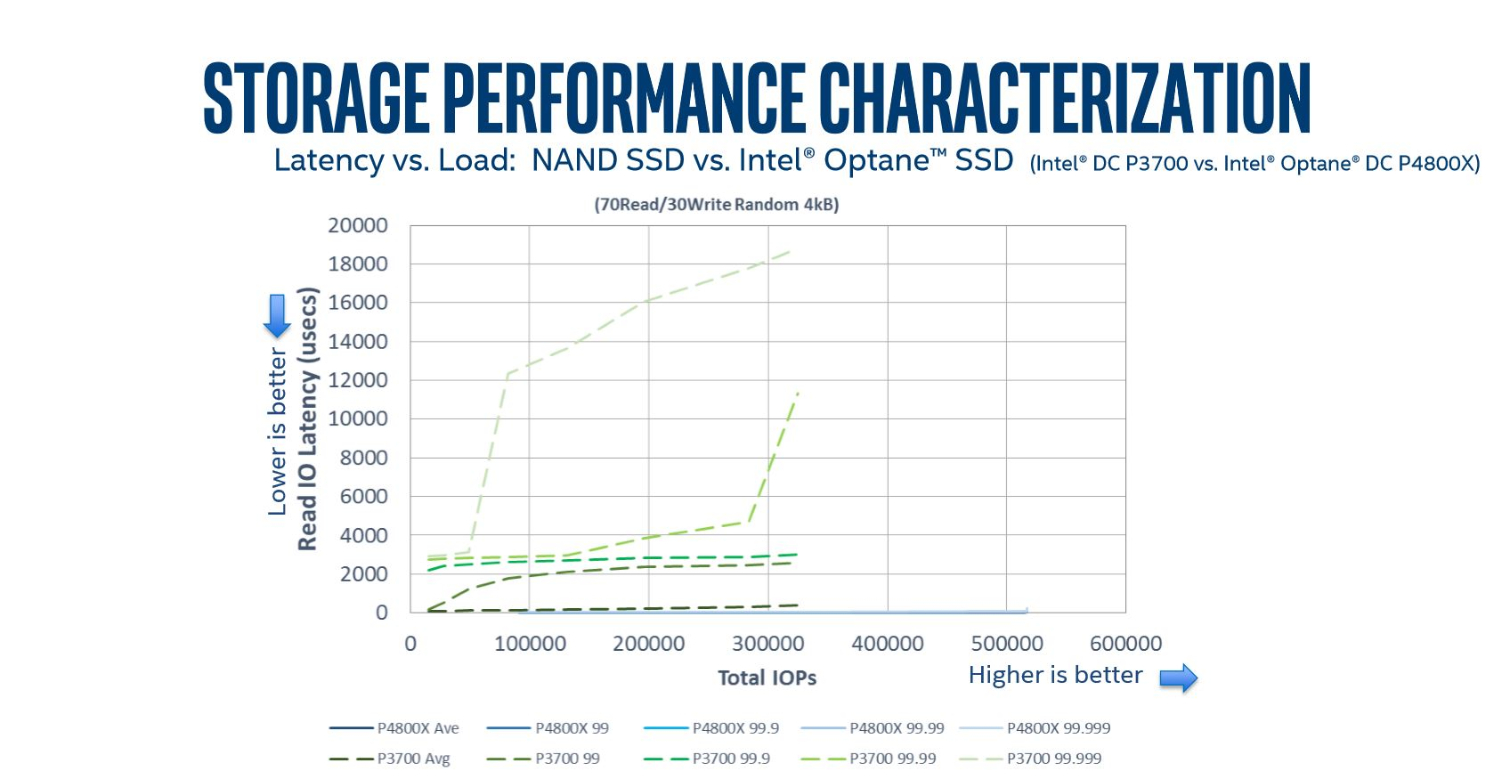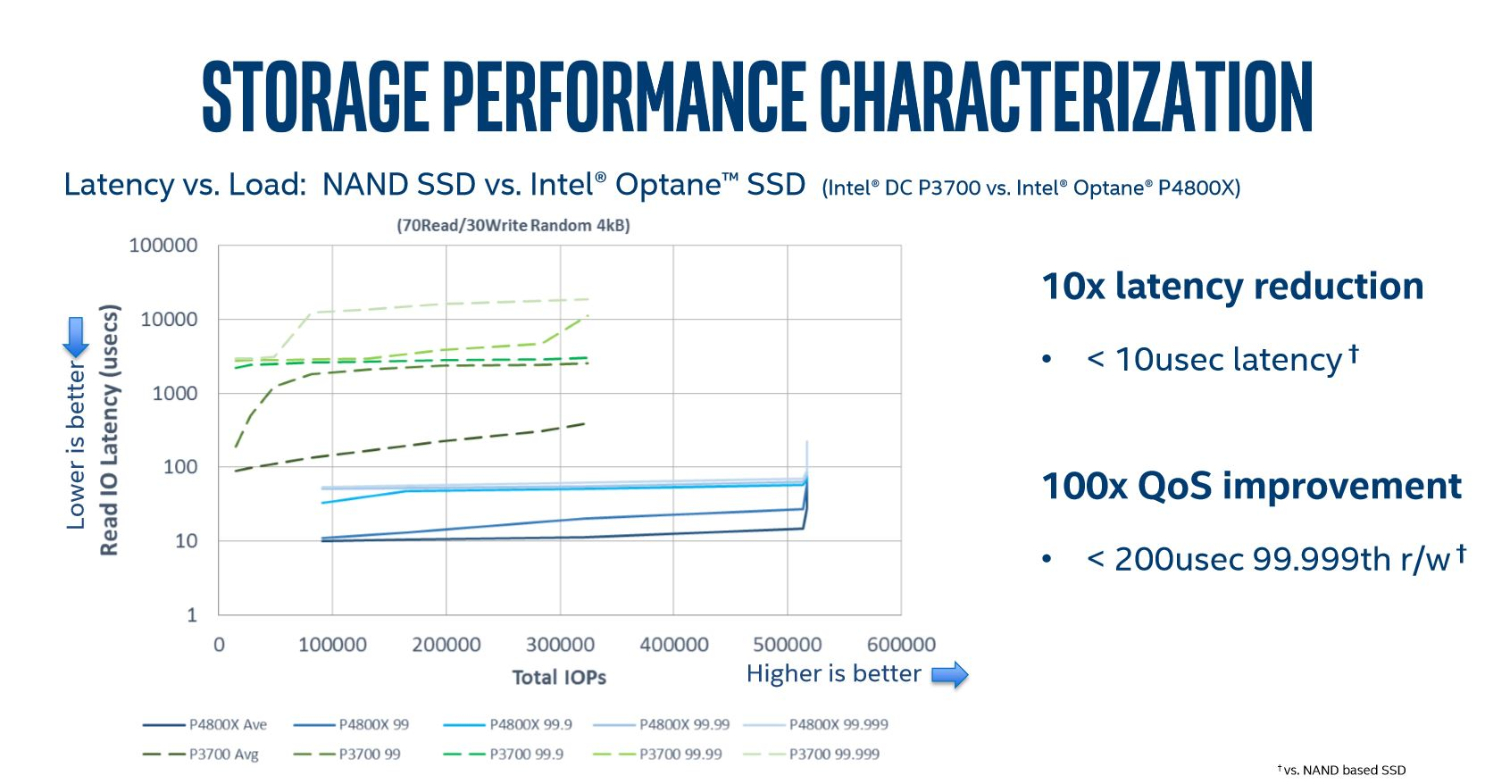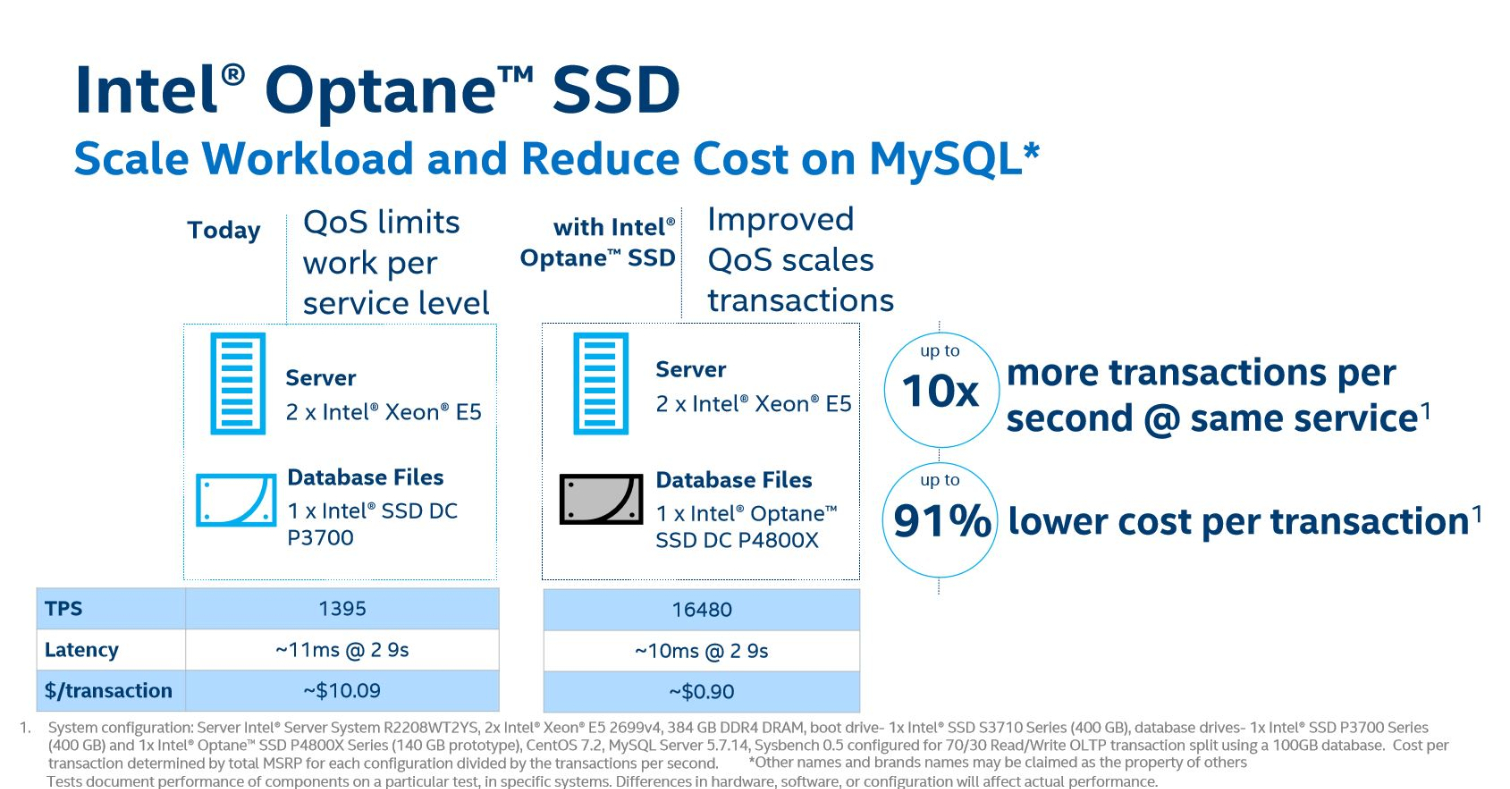3D XPoint Debuts, Intel Announces Optane SSD DC P4800X And Pricing
The NVMe DC P4800X marks Intel's 3D XPoint-powered Optane SSD debut--but it's aimed directly at the enterprise market. Optane is Intel's all-encompassing brand name for the collection of technologies, including 3D XPoint media, memory, storage controller, interconnects, and drivers, that power the new SSD. If Intel sticks to its established trend of releasing consumer versions of its enterprise SSDs, such as the Intel SSD 750, then we might see a similar version come to market one day for desktop PC users, as well.
Word first filtered out about the DC P4800X 'Cold Stream' SSD in February via a leak in several Chinese-language media outlets. We were able to find a conformance document on Intel's website that listed the device and that it employed 3D XPoint media, so we already know a few of the key details.
Now we also know the most important detail: pricing. Intel's DC P4800X will initially come to market as a 375GB AIC (Add-In Card) with a $1,520 price point, or roughly $4.05 per GB, and is available today. The company will add 750GB and 1.5TB capacity points in both AIC and U.2 form factors.
By comparison, we can find Intel's exotic dual-SSD DC P3608, which is currently the company's fastest NAND-based offering, for roughly $1.64 per GB at retail. The DC P4800X carries a hefty premium over NAND-based SSDs, but performance and endurance are the key metrics that will provide far more value for intense workloads.
Intel and Micron made their joint announcement of 3D XPoint, a revolutionary new memory that can be used either as storage or memory, in July 2015. Intel and Micron designed 3D XPoint to bridge the gap between storage and memory, and as expected for the first new productized memory in 25 years, its taken a long and winding road to market. We've covered the technical aspects of the new technology in detail several times as it worked its way through development.
Surprisingly, Intel still isn't revealing exactly what 3D XPoint is, although most analysts agree that it is likely a flavor of PCM (Phase Change Memory). Of course, Intel doesn't want to arm its competitors with too much information, but a chip analysis firm will likely reveal the details once devices are on the market.
| Header Cell - Column 0 | Intel DC P4800X |
|---|---|
| Capacity | 375GB |
| Form Factor | Add-In Card, Half-Height, Half-Length |
| Interface | NVMe, PCIe 3.0 x4 |
| Latency | <10 microseconds |
| Quality of Service (QoS) 99.999% | 4K Random Read/Write QD1 - <60/100 microseconds4K Random Read/Write QD16 - <150/200 microseconds |
| Throughput | 4K Random Read/Write IOPS - up to 550/500K4K Random 70/30 Read/Write Mix - up to 500K |
| Endurance | 30 DWPD - 12.3 Petabytes Written |
| Price | $1,520 |
Intel is shifting its product specifications strategy and isn't officially announcing the P4800X's sequential read/write performance. Instead, the company is transitioning to metrics that it feels better quantify performance for the enterprise target market, such as random and low queue depth performance. As we reiterate in our storage reviews, performance at low queue depths and consistency, in both the consumer and enterprise market, is the true differentiator that has a positive impact on application performance.
Get Tom's Hardware's best news and in-depth reviews, straight to your inbox.




Intel, which has a strong track record of meeting its spec-sheet claims for storage devices, listed the P4800X's latency at sub-10 microseconds (a 10x reduction compared to NAND), and 4K random read/write IOPS weigh in at 550,000/500,000 IOPS. Most importantly, it delivers 5x to 8x the performance of competing SSDs at low queue depths. Mixed random 4K performance with a 70/30 read/write workload measures an impressive 500,000 IOPS, which is far and away the leading performance from any SSD we've covered. Intel noted that the DC P4800X offers nearly the same performance for both read and write workloads, which fuels the impressive mixed workload performance.
Intel also touted its 40x read responsiveness results under heavy load conditions using its "write pressure" test, which measures read latency during heavy write workloads. We typically measure workload latency during mixed read/write tests but present the values as a mixture of both read and write latency--instead of splitting off the read latency. Expect us to give the write pressure test a try when we receive samples.
Intel claimed that its 99th percentile latency (Quality of Service), which measures the worst-case latency during a given workload, is also up to 60x better than its own DC P3700 SSD, which is quite the accomplishment. QoS performance has a tremendous effect on transactional workloads. The refined profile will have a significant impact on database and heavy random workloads.
Endurance is another key metric, and Intel has conservatively spec'd the DC P4800X at 12.3PB written over its three-year warranty period, which equates to 30 drive writes per day (DWPD). Intel indicated that the leading-edge 375GB model would carry only a three-year warranty, but that future models would extend to the traditional five-year period.
Intel also plans to monitor endurance in the field, so it may revise the endurance upward over time. Intel did the same with its DC P3700 series, which the company increased from 10 DWPD to 17 DWPD with little fanfare. In either case, the 30 DWPD figure is impressive; the highest endurance we've seen on a modern SSD is the DC P3700's 17 DWPD, and most are in the 3 DWPD range. The 12-14W active power consumption is also within expectations for a normal NAND SSD. The P4800X retains data without power for three months, per normal JEDEC standards.
The NVMe DC P4800X employs 20nm 128Gbit (16GB) 3D XPoint dies with CMOS Under the Array (CuA) technology, which increases density by placing the control circuitry under the storage array instead of on the periphery. The SSD employs a custom 7-channel Intel NVMe ASIC that can manage up to four die per channel, or 28 total die. We're accustomed to seeing up to massive 16-channel fire-breathing controllers on standard enterprise PCIe SSDs, so wringing that much performance from a single 7-channel ASIC implies that it is incredibly efficient. Intel indicated that it uses hardware-accelerated read/write paths, so there is no firmware to interfere with the data path. This sounds rather akin to host-managed SSDs that have limited compute on the actual device, such as Fusion-io's offerings, but we'll have to await more detail.
The DC P4800X doesn't use overprovisioning in the traditional sense, which is to increase performance and endurance. Instead, it uses a very small amount of extra space for ECC and metadata at the device level, and unlike NAND, it doesn't include any built-in overprovisioning at the die level. This tracks well with information we learned last year.
Unlike NAND, 3D XPoint is a write-in-place memory, so the SSD controller doesn't have to erase existing data before writing new data. Eliminating the extra write cycle increases endurance and performance. It also simplifies device management by removing the read-modify-write garbage collection process. The underlying storage medium is also bit-addressable, so in contrast to NAND-based SSDs that write in larger chunks, the DC P4800X can break small amounts of 4K data into several chunks and spread them across multiple die, which boosts performance. The DC P4800X uses wear-leveling algorithms to ensure consistent wear across the media.
Intel provided several charts that quantify the DC P4800X's incredible latency-to-IOPS profile, and in the first slide, the DC P4800X is barely visible as a blue line at the bottom of the chart. We've charted SSD latency like this for several years, but for normal SSDs, we plot queue depth along the X axis. Charting load under various queue depths makes sense for NAND-based SSDs, but switching to an IOPS-based axis is more appropriate for 3D XPoint because it highlights the extreme performance differential.
We have to view the data on a logarithmic scale, with each tick increasing by a factor of 10, to allow us to see the P4800X's measurements of various 99th percentile measurements. It's easy to see that the NAND-based DC P3700 is no match for a 3D XPoint device.
The increased performance and QoS yields impressive gains in transactional workloads, which in turn lowers the actual cost-per-transaction. Increased performance, in this case, yields denser compute platforms and offsets the DC P4800X's higher price point.
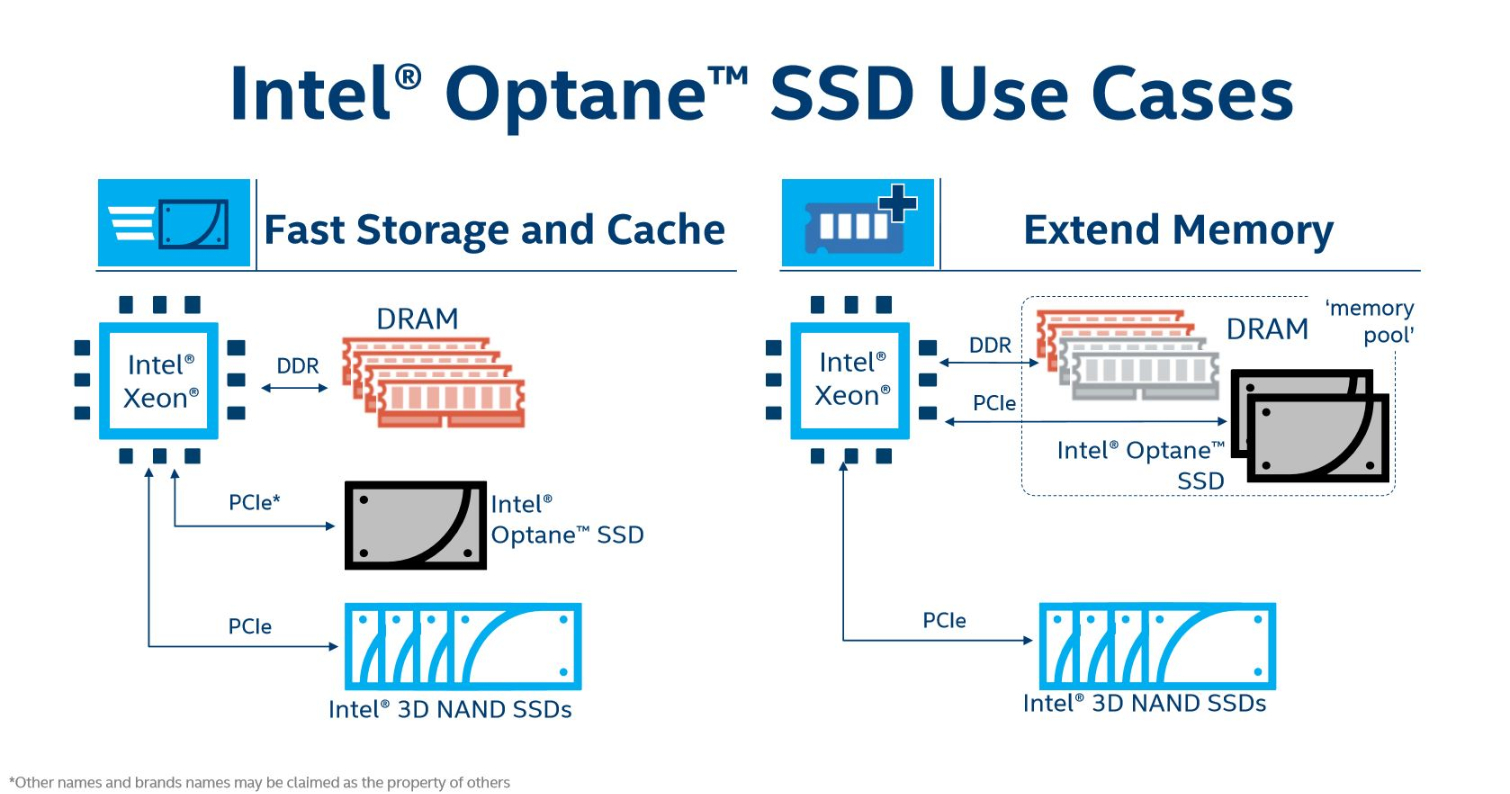


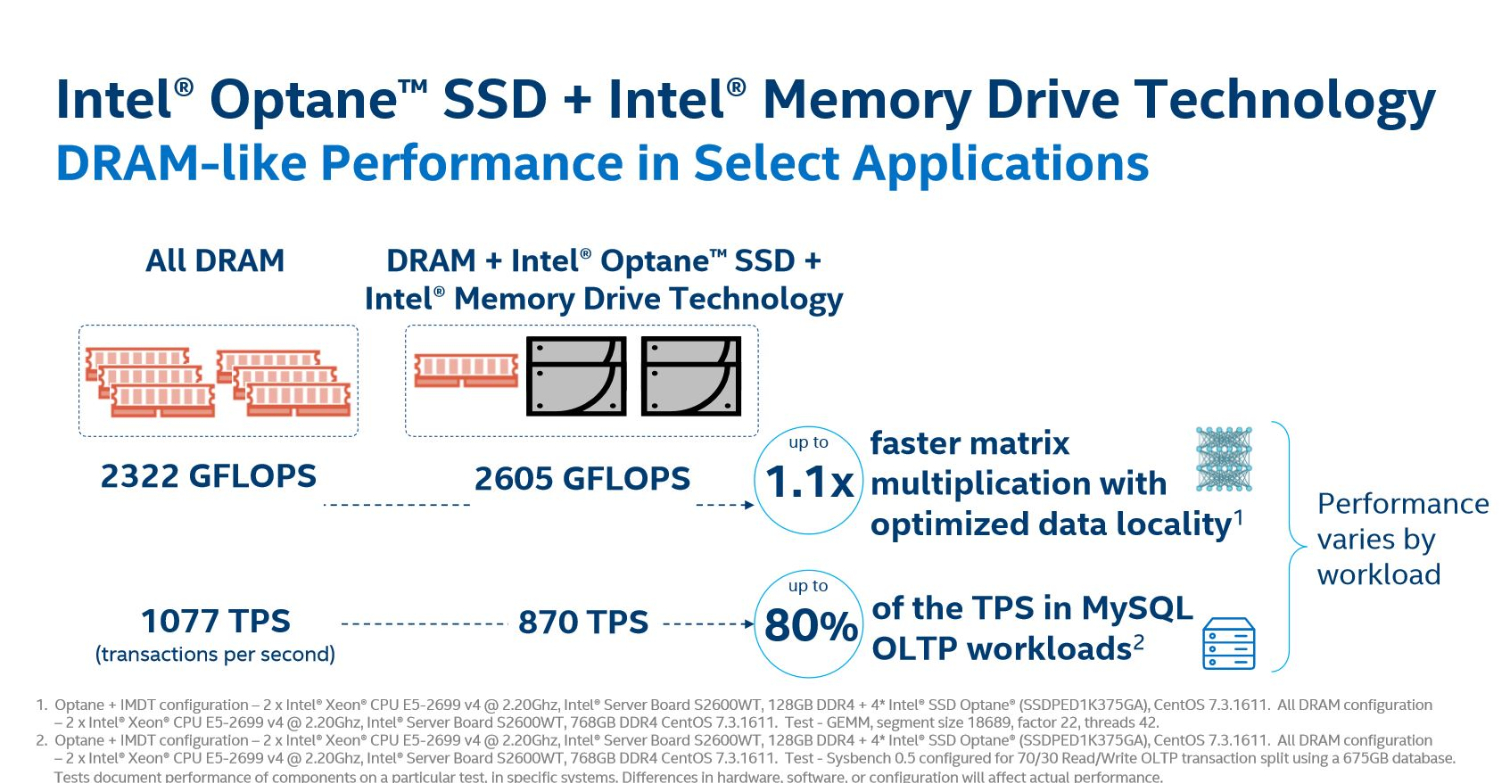


3D XPoint is fast enough to be used as a slower tier of memory that delivers many of the same advantages of DRAM, but at a much lower cost and in a denser package. The industry is hard at work developing the underpinnings of addressing next-generation non-volatile memories with normal memory semantics, but Intel also offers its value-add Memory Drive Technology. The software merges the DC P4800X into the memory subsystem so that it appears as part of a single large pool of memory to the host.
The technique has tremendous potential, especially in the in-memory compute space, and it will be a huge attraction to hyperscale data center operators. Most importantly, it doesn't require any changes to the existing operating system or applications. The software is supported only on Intel Xeon platforms and adds $430 to the price of the Optane solution. In our opinion, the Memory Drive Technology is probably one of the most important aspects of the launch, as utilizing NVDIMMs, and other methods of enhancing the addressable memory pool, tend to be kludgy and require significant optimization of the entire platform at both the hardware and software level, which hinders adoption. A plug-and-play solution will enjoy tremendous uptake.
Intel has aligned a bevy of ecosystem partners to enable the new platform, and we expect the list to expand rapidly. Micron is also on the cusp of releasing its QuantX products, which should foster even faster adoption of the new technology.
Intel noted that it kicked off the SSD era with its X-25M products, which it sold $12 million worth of the first year. Today, the SSD market is a $20 billion industry. It's possible that 3D XPoint could enjoy a similar growth trajectory, but this time around, the product is confined to only Intel and Micron, whereas the SSD industry consists of multiple companies. The exclusivity could be a boon, as it confines the profits to only two players. With a great entry price point, it's possible that 3D XPoint could take off much faster than many predicted. We'll know soon enough; the full suite of products hit the shelves for general availability in the second half of the year.
EDIT 4/19/17 9:19AM CST: Corrected availability.

Paul Alcorn is the Editor-in-Chief for Tom's Hardware US. He also writes news and reviews on CPUs, storage, and enterprise hardware.
-
hannibal Good, now it starts! First devices are out. In three to five years normal consumer can also afford these!Reply
It will be interesting to see these tested in real usage! -
Elixon This is fake news. How could the author forget to mention that Intel/Micron promised "Game-Changing 3D XPoint Memory, 1000x Faster Than NAND"? You lay down "10x faster" fact in front of readers without even checking what it was supposed to be and what Intel realy delivered?Reply
That is unprofessional and I smell the ad revenue from Intel. -
memadmax SCREW YOU INTEL AND MS!Reply
Optane/Xpoint are gonna be "Win10 Only"
You feel the noose getting tighter yet? You have been warned, again(and many times before!)...
They might as well rename it to: "MicroApple".... -
Paul Alcorn Reply
We've already covered the disparity between the initial speed claims, which apply to the media only, and not the device level performance.19447925 said:This is fake news. How could the author forget to mention that Intel/Micron promised "Game-Changing 3D XPoint Memory, 1000x Faster Than NAND"? You lay down "10x faster" fact in front of readers without even checking what it was supposed to be and what Intel realy delivered?
That is unprofessional and I smell the ad revenue from Intel.
Here is some fairly critical coverage of that, which we linked to in this piece.
See the sections named "original claims" and "walking it back":
http://www.tomshardware.com/reviews/3d-xpoint-guide,4747.html
-
valeman2012 Not worth it to pay that much just to get that performance.Reply
Stick with my myDigtal SSD NVMe -
Tanyac Unless my maths is faulty isn't this about $4.00 per gigabyte? Will enterprises really be willing to pay that much for space? 375GB is a small drive so it's not a good choice for large storage applications. The performance doesn't seem that groundbreaking.Reply
In AUD that thing will probably cost $2200, about $5.85 AUD per gigabyte. That's got to be hard to justify, surely?
I must admit I'm no guru when it comes to comparing SSD performance, so how does this compare to say, the Samsung 960 Pro, which is about $0.80 AUD per gigabyte for the 1TB drive? -
Ok, this is impressive. After a disappointing start, the "word on the street" was the first cards would be 16 GB, 32 and 64. Now it's 375 GB from the get go. It's still not enough, but it's a good start. And the price point is fine for now. They will sell a lot of these.Reply
-
ssdpro Reply
It isn't impressive at all. It is not a consumer product and Intel said there would be a consumer product on the way. Those are still slated to be 16-64GB and will be expensive still.19448895 said:Ok, this is impressive. After a disappointing start, the "word on the street" was the first cards would be 16 GB, 32 and 64. Now it's 375 GB from the get go. It's still not enough, but it's a good start. And the price point is fine for now. They will sell a lot of these.
And as for data centers, yes they will pay for this. Intel has likely already sampled to MS, Netapp, Amazon, Brocade, etc and has buyers in place for the tech.
-
alextheblue Reply
I really hope they'll be affordable enough to at least use as a boot drive/cache in a couple of years. For a cache drive in particular it wouldn't need to be that large. If they're fast enough it might be worth it to run something like a ~100GB cache in tandem with a larger conventional SSD drive, for example.19447743 said:Good, now it starts! First devices are out. In three to five years normal consumer can also afford these!
Today this is useful for professional/business systems. In the near future, it (or other post-NAND storage tech) will be available in common consumer form factors at a more affordable price. So making a statement like that just seems a bit silly on a tech site.19448079 said:Not worth it to pay that much just to get that performance.
Stick with my myDigtal SSD NVMe -
CRO5513Y Reply19449329 said:
I really hope they'll be affordable enough to at least use as a boot drive/cache in a couple of years. For a cache drive in particular it wouldn't need to be that large. If they're fast enough it might be worth it to run something like a ~100GB cache in tandem with a larger conventional SSD drive, for example.19447743 said:Good, now it starts! First devices are out. In three to five years normal consumer can also afford these!
Today this is useful for professional/business systems. In the near future, it (or other post-NAND storage tech) will be available in common consumer form factors at a more affordable price. So making a statement like that just seems a bit silly on a tech site.19448079 said:Not worth it to pay that much just to get that performance.
Stick with my myDigtal SSD NVMe
^ This, in a couple of years should make for good boot and priority app/game drives. Just like SSDs it will take time to become affordable for consumers but that's just how it is not much we can do about it but whinge at Intel and storage manufactures lol. Additionally, people still complain about Windows 10 exclusivity? Just get used to it they aren't going to just stop with DirectX 12 and Kaby Lake. Should have rolled with the free update when it was out. Windows 10 has been the most convenient and fast Windows OS for me since 7 and before that XP. Anyone on a modern gaming PC should have Windows 10 unless you dont want modern hardware support, better drivers, faster boot and DirectX 12 support among other things... Just for reference i have moved to every new Windows since 2000 and although some have been rough (Vista and Windows 8 for sure) 10 has been exceptional so far, too many people on the "Windows 10 spies on you" bandwagon and if you think Windows 10 spies on you then why are you on the internet to begin with... your ISP is spying on you, your phone manufacturer is spying on you, CIA is spying on you.... list could go on so not much point squalling at Microsoft for being a business trying to make money and nothing wrong with ending support for a OS that is now over 7 years old. :P



